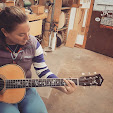 |
| DeeDee keeping watch from her peghead. |
I have named my new White ash guitar DeeDee. The new owner asked me to inlay the likeness of his wife's favorite goat (DeeDee) into the back of the peghead. Even though the inlay sort of resembles a cartoon of a goat, I promise that is really what she looks like in the photographs that were sent over. What do you think, does she look like a goat to you?
I always get so excited about hearing new guitars, but this one I was especially eager to hear because I have never heard an ash guitar before. I must admit that it sounds surprisingly lovely, with waves of energy bursting from the soundhole. To me, it sounds strong, confident, and playful. Now I know, describing the way I hear something is kind of ridiculous since, as I learned in perception class at NC State, we all take in external stimuli differently, so what I hear is never going to equal what you hear. You'll just have to take a visit to the shop and see for yourself! Before Thanksgiving would be best as it will be headed home after that.
I love that each instrument I build (or my dad builds, or Martin, etc.) has a personality all its own that you can pick out from the first strum of the strings. The sound I hear in my ukulele is very different than the peppy ash guitar. To me it sounds mellow and laid back, just how I would picture someone relaxing in a hammock on a beach in Hawaii. Instead of being built from Hawaiian koa however, I chose a beautiful set of blistered maple that I stained dark to bring out the bubbles within the grain. I sanded the pieces that make up the body quite thin, similar to the thickness of the top and back of the 1920s Martin ukulele my dad has that sounds incredible. I figured maple would likely be the strongest material to withstand such thin pieces, and I have always enjoyed the sound of maple instruments, so now here we are!
 The bridge needs a little bit if explanation. I want to practice what I preach, and stay away from unsustainable/illegal materials when possible, so to tell you the bridge of my ukulele is made from ivory might cause a look of skepticism to cross your face. Let me set the record straight. My dad met a woman at the Puget Sound Guitar Workshop one of the many summers he has been teaching there. She sent him a carved African statue made from an elephant tusk. We aren't sure exactly how old the statue is, but when my dad's friend hosted a Peruvian exchange student, the student's father, who had been working in East Africa, presented her with the statue as a gift. It was brought into the US well before the ban on ivory and has never been sold or bartered.
The bridge needs a little bit if explanation. I want to practice what I preach, and stay away from unsustainable/illegal materials when possible, so to tell you the bridge of my ukulele is made from ivory might cause a look of skepticism to cross your face. Let me set the record straight. My dad met a woman at the Puget Sound Guitar Workshop one of the many summers he has been teaching there. She sent him a carved African statue made from an elephant tusk. We aren't sure exactly how old the statue is, but when my dad's friend hosted a Peruvian exchange student, the student's father, who had been working in East Africa, presented her with the statue as a gift. It was brought into the US well before the ban on ivory and has never been sold or bartered.To be delicate, the sculpture did not exactly boast the cutest face you'd ever seen carved into something. According to my dad's friend, her grandson was scared of it, so she put it away in a closet after it sat, displayed in her living room, for several decades. Her children had no interest in inheriting the artifact, so she sent it along to my dad, hoping he would be able to use it to make nuts and saddles for guitars. She hoped for something good to come of the statue for which a majestic elephant had sacrificed one of its tusks many many years ago. After the statue glared at us from a shelf behind the bandsaw for several months, my dad finally decided to make use of it. He offered to give me a piece to make an old-timey pyramid bridge for my ukulele. I think these bridges are one of the most beautiful, elegant pieces that can be added to a guitar and figured a little one for a ukulele would look extra neat. "You reckon an African spirit is going to come haunt us if we cut this thing up?" He asked. I was not sure, and am still a little concerned that I might have a cursed ukulele on my hands, but I think it is worth the risk. The gift of this sculpture has brought joy and happiness to me, as now I have a beautiful ukulele that sounds and looks way too good for who it is for. ;-)
























































